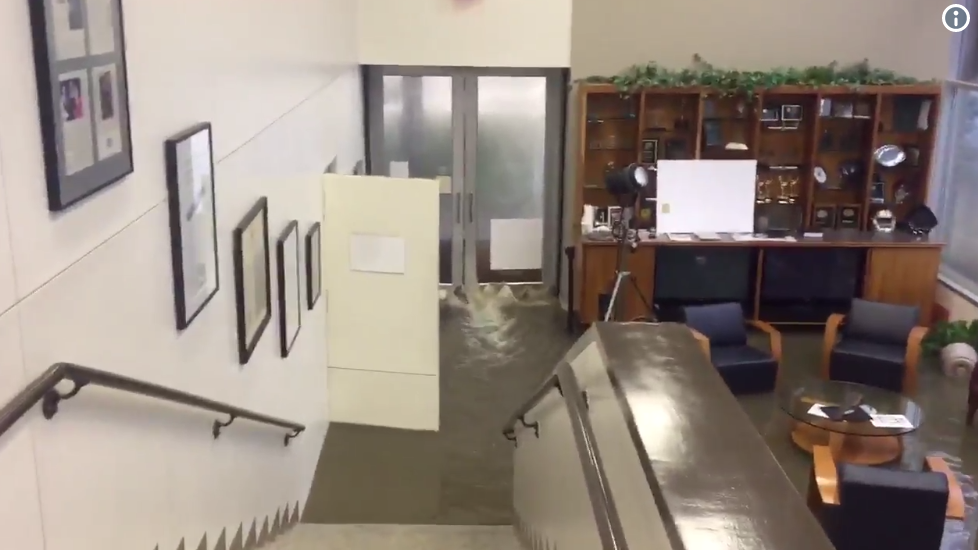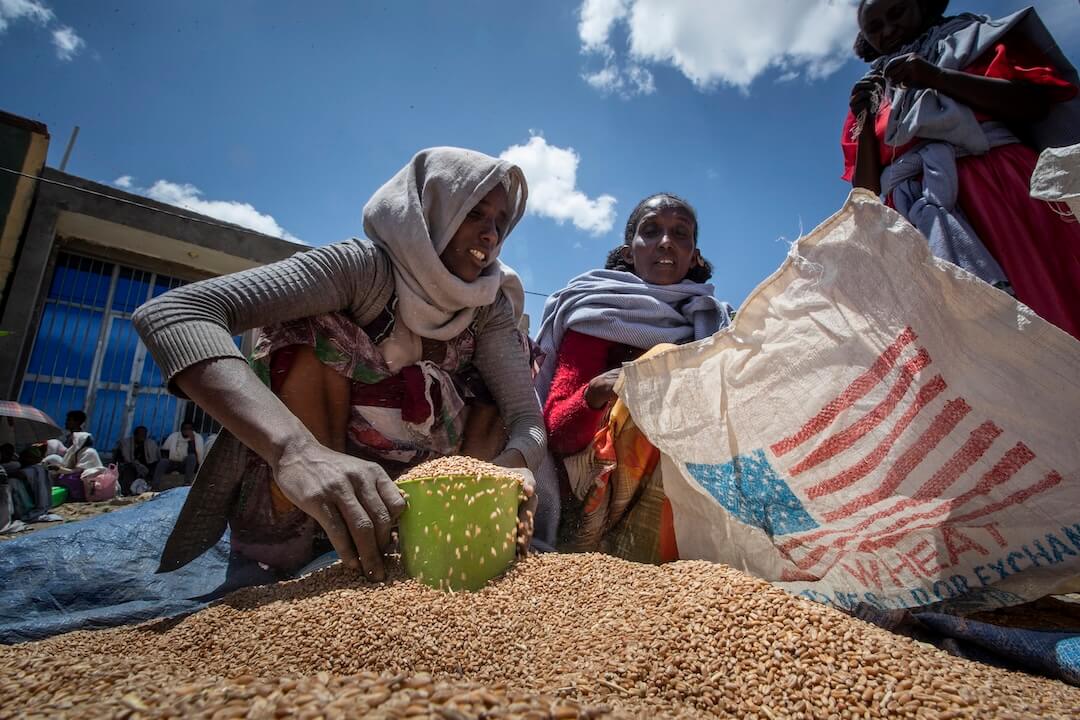Hurricane Harvey may have forced the journalists at KHOU-TV to evacuate. But they didn’t stop covering the storm.
The Houston-based CBS affiliate was covering the floods when water began to seep into the studio. The station, which is across the street from the Buffalo Bayou river, took on water up to the anchor desk while Len Cannon was on the air.
KHOU social media reporter Doug Delony posted video of Cannon on the air talking about the flood while water was rising around his shoes.
We are now on the second floor and live!!!! Victory!!! #KHOU11 pic.twitter.com/oBmHsZiU4u
— Josh Hubbard (he/him) (@JoshHubbsNews) August 27, 2017
But later, as water poured into the station’s lobby and alarms buzzed, News Director Sally Ramirez posted a video saying the KHOU was evacuating the building. KHOU has flood barriers around the building, but it was not enough to hold back Harvey’s historic rain.
The station dropped off the air for nearly seven hours after it moved two blocks away to the Federal Reserve building. With the help of sister Tegna station WFAA, KHOU was able to stay live on its website and social media pages while engineers scrambled to get a signal back on the air.
The station had a plan to move to the nearby Houston PBS station in an emergency. But by the time it was clear evacuation was necessesary, the water was too high to make it to the public TV station.
Just after 6:30 p.m., the station was back on the air. Other Houston stations have broadcast nonstop on air, online and on social media.

From Sally Ramriez, KHOU.
The same bayou that flooded KHOU flooded KTRK sports photojournalist Joe Gleason’s townhouse. He posted video of the damage on the station’s website. “The water is a little below my knee downstairs,” he said.
KRIV, the Houston Fox affiliate showed how severe the Buffalo Bayou flooding is.
Just getting to work in Houston required ingenuity Sunday. KTRK executive producer Keith Browning kayaked to work.
Texas TV reporters didn’t just talk to viewers, they listened.
“Social media has made the storm completely interactive,” said KTRK reporter Ted Oberg. “We are hearing from viewers in real-time and are able to answer specific questions for them on-air and online. I took Facebook questions on storm coverage while standing on the coast and most importantly, something I should have known but forgot in the midst of the landfall timing and category strength, the emotional toll of storm anxiety could be crippling for our audience and we should spend more time talking about it.”
Viewers who could not contact rescue workers pled for help on social media:
I have 2 children with me and tge,water is swallowing us up. Please send help.
11115 Sageview
Houston,Tx.
911 is not responding!!!!!!— Maritza RITZ Willis (@RitzWillis) August 27, 2017
The children and I are safe. Thank you everyone and thank you Facebook!!!!!! The miracles of social media. Forever grateful!!!
— Maritza RITZ Willis (@RitzWillis) August 27, 2017
KHOU Reporter Brandi Smith was live on the air when she noticed a van heading for deep water. She got the attention of a nearby tow truck driver, and together they pulled the driver from the vehicle.
https://twitter.com/JMKTV/status/901842756829679616
Later in the day, CNN reporter Ed Lavandera and camera crew was about to leave a Houston neighborhood in a boat when he heard a family hollering. The CNN crew rescued the family from the floodwaters.
Lavandera said it was an emotional moment because one of the family members had Alzheimer’s. CNN decided to cut away from the rescue until they knew her condition. Once the family was safely on the boat and on the way to waiting family members, Lavandera interviewed family members, again, live on the air.
A powerful moment on @CNN just now — a flood rescue with @edlavaCNN https://t.co/4Icgn35WzV
— Ana Cabrera (@AnaCabrera) August 27, 2017
Other people posted pleas for help from the rooftops of their homes. One person posted that he was a cancer patient with a feeding tube and was stranded. The sheriff’s department used Twitter to ask for help rescuing a stranded pregnant woman who was going into labor. KHOU reported that woman was rescued and taken to a hospital.
This man is a preacher checking for people inside cars at 610 & 288 PC Brian Roberson Jr @KPRC2 #Harvey pic.twitter.com/NJx58ZN8N8
— Sara Donchey (@SaraDonchey) August 27, 2017
TV stations across Texas captured water rescues. KRIV found two men hanging on to a freezer as they floated to safety. Another woman grabbed an air mattress and floated her dogs and belongings out of her house to a dry bridge underpass in Houston.
Just as Hurricane Harvey was strengthening into a Category 4 storm, anchors on the air at KIII in Corpus Christi noticed the entire station was shaking. They pointed the studio cameras to show ceiling panels in the studio shaking. “We’re beginning to rock and roll in here,” one anchor said.
Houston TV stations are already getting help from other stations around the country. Tegna, for example, sent crews to both Houston and Rockport to support KHOU. A Tegna station in Jacksonville, Florida sent KHOU an online producer who had fresh experience covering hurricanes after Hurricane Matthew hit the Florida coast last year.
KHOU also turned to its Tegna sister, Dallas’ WFAA, for help. WFAA provided meteorologists to anchor live coverage while KHOU tried to get back on the air.
When they evacuated to the Federal Reserve building, KHOU journalists lost access to its monitors and radar. They also lost the ability to communicate with reporters who were ready to go live. But since WFAA and KHOU have the same ownership and use the same “TVU grid,” WFAA was able to switch the KHOU reporters live online and on Facebook.
New bonded-cellular technology is allowing Texas TV stations to cover Harvey in ways they could not have when microwave and satellite trucks were the only way to report live from the field. Stations using portable transmitters from TVU, LiveU and Dejero can go live anywhere they can connect to a cellular signal.
The technology has its problems. Crews who were reporting from Rockport, Texas said they had to drive around to find a signal that they could use to “go live.”
While meteorologists track the storm, field crews put faces and names on the catastrophe.
“A woman taking her grandkids to the evacuation bus stopped me cold,” Oberg said. “She smiled listening to her 4-year-old grandson describe the coming bad weather. She smiled when I asked her why she was leaving.”
But when he asked what scared her, she broke down.
“Through tears she admitted she hadn’t slept in days and was so worried about how her kids and sick husband would get off the coast, I was focused on how bad the damage would be, for her, the storm was already devastating.” Oberg, a veteran of tragedy and storm coverage, said journalists owe the public “every ounce of empathy we can summon.”
Late Sunday night, while Oberg was covering the floods, his own family was being told that it might be time to evacuate.
“My wife and girls are there,” he said. “I’m miles away and separated by high water. Can’t get home. They will be fine. We’re up high. But it’s a new feeling to get that kind of message. It’s not about me, but wives and husbands and partners who manage while we work.”
Hundreds of journalists share that feeling. They’ll be working non-stop for weeks covering this disaster while their families mop up and begin repairs.
This is my neighborhood. My home has flooded. That's my wonderful son. This was his birthday weekend. I love you. #khou #HouNews pic.twitter.com/CHFNIcDsdM
— The Bishop (@BillBishopKHOU) August 27, 2017
Correction: Owing to an editing error, an earlier version of this story misspelled Len Cannon’s name.







